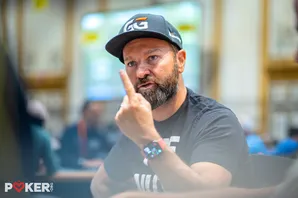Jim Reid is a longtime lover of poker, a member of the PokerOrg Player Advisory Board, and host of the popular RecPoker podcast.
In the first part of this article we covered the why and the when of going ‘almost all-in’ - shoving almost your whole stack, while leaving a chip or two behind as a means to ladder-up if the situation is right. But deciding how many chips to hold back when you do this depends on where you are playing, and their tournament format.
Some tours and governing bodies use the ‘ante first’ format, and some use the ‘big blind first’ format. The difference between them only ever comes up in situations where the player in the big blind has fewer than 2 big blinds in their stack, but it’s a situation worth considering, because in those cases the chips in the ante are not ‘matched’ by the other players in the hand in the same way the chips in the big blind are. So you can only win from other players the amount you have in the big blind, not what you put into the ante.
To make it perfectly clear, let’s look at an example and the two different ways it can play out.
The ‘big blind first’ format
The blinds are 500/1K with a 1K big blind ante. You are in the big blind with 1,100 chips. In the ‘big blind first’ format, you post your big blind first for 1,000 and your remaining 100 chips go into the ante, making for a smaller ante than usual. In this case you are all-in, and if someone else open-raises or limps, you can win from other players in the hand the full 1,000 chips of your big blind, and at least 500 chips from the small blind. Plus, if everyone including the small blind folds, you can even win the hand without showdown!
So even though this is a bad situation to be in, at least you can double or triple your stack by winning this one hand. So if you are playing in a ‘big blind first’ tournament, all you need to hold back is one full big blind to maximize the amount you can win from other players.
The ‘ante first’ format
In the ‘ante first’ events, in the same situation as that above, you would put 1,000 chips into the ante first, leaving only 100 chips left for you to post in the big blind. While all the other players would still be playing with a nominal big blind of 1,000 chips, you would only be eligible to collect 100 chips from each player, including the small blind!
So if one player raises and everyone else folds, the most you can win is 100 from them and 100 from the small blind and your own 1,000 ante back: if you win the hand, you gain 200 chips, but if you lose the hand you lose all 1,100! A devastatingly negative value proposition. This is a situation you must avoid at all costs, even if it means shoving any two cards from under the gun, when you would next be in the big blind.
That’s why in the ‘ante-first’ format, it is best to hold back two full big blinds instead of one. It’s that simple. Then you are posting a full ante and a full big blind and you can leverage the full value of your chipstack. And of course make sure to watch the clock for when the blinds will next go up - you might need to hold back more chips than you thought by the time your next big blind comes around!
Get informed before you need to be
The best way to find out what format your tournament uses is to ask the floor before it becomes an issue. Often different cardrooms will have different ‘house’ rules that it’s worth asking about before you play there for the first time, and whether they are ‘ante first’ or ‘big blind first’ is a good question to have on your list.
I believe the WSOP uses big blind first, whereas the WPT and the TDA use ante first. But don’t take my word for it: ask the floor before you play. And then next time you are going all-in, think about all of your options and make the best poker decision you can.
Image courtesy of Danny Maxwell/Rational Intellectual Holdings




















